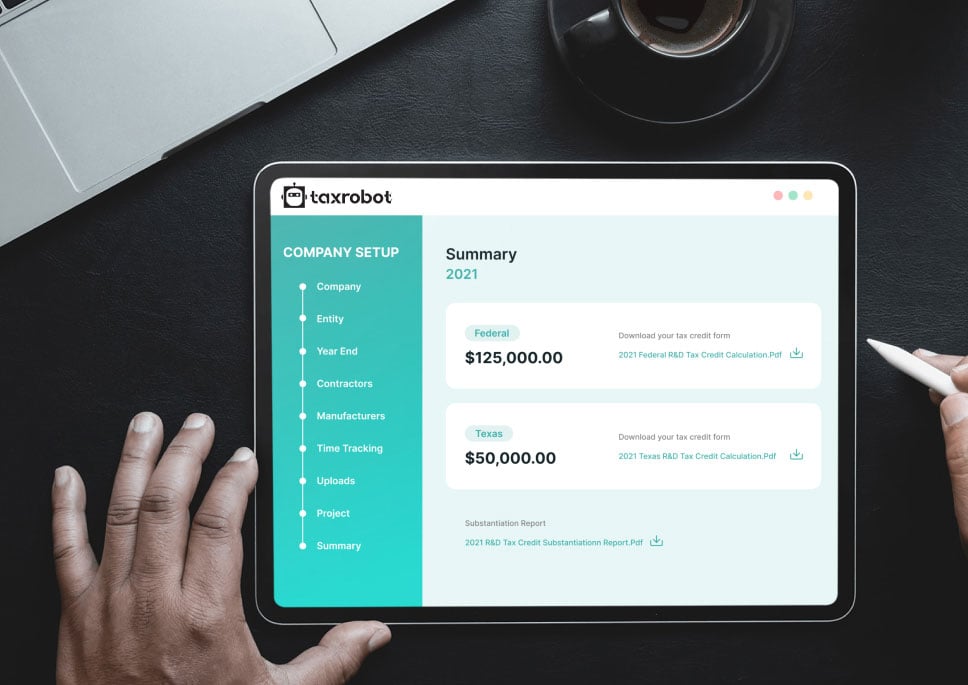New Hampshire R&D Tax Credit
With TaxRobot, New Hampshire R&D Tax Credit becomes more than a benefit—it becomes a catalyst for your business growth. Unleashing the incredible, simplifying the complex. This is not just tax planning; it’s financial evolution.
Maximize your State Credits today!
Put the R&D tax credit process on autopilot.
Trusted By:








New Hampshire R&D Tax Credit
Discover your eligibility for New Hampshire R&D tax credits and supercharge your enterprise.
Streamline Your New Hampshire R&D Tax Credit Process with TaxRobot
Are you looking to maximize your R&D tax credits in New Hampshire? Look no further than TaxRobot, the AI-powered solution designed to simplify and streamline the entire process.
With the New Hampshire Research and Development (R&D) Tax Credit Program offering substantial benefits, TaxRobot is here to help you navigate the complexities effortlessly. Our fast onboarding and user-friendly platform ensure a hassle-free experience while delivering a maximum refund.
Say goodbye to tedious calculations and hello to TaxRobot, your trusted partner in unlocking the full potential of R&D tax credits.
Details of the New Hampshire R&D Tax Credit
The New Hampshire Research and Development (R&D) Tax Credit Program, established in 2007, offers businesses a valuable opportunity to claim tax credits for qualified R&D expenses.
With a maximum credit limit of $7,000,000 per fiscal year, eligible businesses can benefit greatly. This program calculates the credit as 10% of the excess of qualified R&D expenses over the base amount.
Qualified expenses include wages paid to employees for services rendered in New Hampshire, as reported under section 41 of the Internal Revenue Code.
The R&D tax credit application (Form DP-165) must be submitted by June 30 following the tax year. The awarded credit can be applied against the Business Profits Tax (BPT) first, with any remaining amount used for the Business Enterprise Tax (BET).
The credit can offset tax liability within 5 tax years, providing businesses a valuable tax-saving opportunity.
Simplify Your R&D Tax Credit Calculation With TaxRobot
Calculating R&D tax credits can be complex and time-consuming, but TaxRobot is here to simplify it. With our AI-powered software, we streamline the calculation process, making it efficient and hassle-free.
Whether you’re a small startup or a large corporation, TaxRobot’s fast onboarding and easy-to-use platform ensure a seamless experience. Our software handles intricate calculations by providing the necessary information and linking your systems, saving you valuable time and resources.
With TaxRobot, you can rest assured that you’re maximizing your R&D tax credits while minimizing the administrative burden. Our expertise in R&D tax credits and our commitment to delivering exceptional service make TaxRobot the trusted choice for businesses seeking a simplified approach to R&D tax credit calculation.
Let us handle the complexities while you focus on driving innovation and growth.
Value-Based Pricing for Maximum Refund
At TaxRobot, we believe in providing value to our clients. We offer a value-based pricing model for our R&D tax credit services. You only pay a fee if you receive a tax credit, ensuring our interests align with yours.
Our goal is to help you maximize your refund; our track record speaks for itself. With TaxRobot, you can rest assured that you’re getting the most out of your R&D tax credits while enjoying the peace of mind that comes with our transparent and fair pricing structure.
Audit Support and Superior Documentation
TaxRobot understands the importance of audit support and robust documentation regarding R&D tax credits. In the event of an audit, we have you covered. Our dedicated team is experienced in handling audit inquiries and will support you.
With TaxRobot, you can trust that our superior documentation meets statutory and IRS-recommended reporting requirements, giving you confidence and peace of mind.
Rest easy knowing that you have a reliable partner, ready to navigate any audit process with efficiency and expertise.
Maximize Your New Hampshire R&D Tax Credits with TaxRobot
TaxRobot is your trusted partner in simplifying and optimizing your R&D tax credit process in New Hampshire. Our AI-powered software streamlines complex calculations, saving you time and resources while ensuring accurate results.
With our value-based pricing model, you only pay when you receive a tax credit, providing maximum refund potential. Count on TaxRobot’s expertise, supported by superior documentation, to confidently navigate audits.
Whether you’re a small business or a large corporation, our goal is to help you unlock the full potential of the New Hampshire R&D Tax Credit Program.
Take a sneak peak

- Limited Time Offer
- Simple Onboarding
- Easy to Use
R&D Tax Credits FAQs
The four-part test as outlined in the Internal Revenue Code is used to determine qualified R&D activity.
The Four-Part Test
1). New Or Improved Business Component
Creation of a new product, process, formula, invention, software, or technique; or improving the performance, functionality, quality, or reliability of existing business component.
- Construction of new buildings or renovation of existing buildings
- Invention of a software application
- Manufacturing of a new product or the improvement of the production process for an existing product
- Creation of design documentation
2). Technological In Nature
The activity fundamentally relies on principles of the physical or biological sciences, engineering, or computer science. A taxpayer does not need to obtain information that exceeds, expands or refines the common knowledge of skilled professionals in a particular field.
- Physics (relationship between mass, density and volume; loading as the
result of gravitational attraction) - Engineering (mechanical, electrical, civil, chemical)
- Computer science (theory of computation and design of computational systems)
3). Elimination Of Uncertainty
Uncertainty exists if the information available to the taxpayer does not establish the capability or method for developing or improving the business component, or the appropriate design of the business component.
- The capability of a manufacturer to create a part within the specified tolerances
- The appropriate method of overcoming unsuitable soil conditions during construction
- The appropriate software design to meet quality and volatility requirements
4). Process Of Experimentation
A process designed to evaluate one or more alternatives to achieve a result where the capability or method of achieving that result, or the appropriate design of that result, is uncertain as of the beginning of the taxpayer’s research activities.
- Systematic process of trial and error
- Evaluating alternative means and methods
- Computer modeling or simulation Prototyping Testing
The R&D tax credit is one of the most misunderstood tax incentives available. Considering the myriad of industries and activities that legally qualify for the credit, the term “research and development” is a misnomer. Additionally, the R&D tax credit requires specialized knowledge and technology to identify and calculate the incentive properly.
Companies of various industries are unaware that they are eligible to claim the R&D tax credit. Under the Internal Revenue Code’s definition of R&D, many common activities qualify. You can get tax benefits for industries including software, technology, architecture, engineering, construction, manufacturing, and more.
The R&D tax credit can be claimed for all open tax years. Generally, open tax years include the prior three tax years due to the statute of limitations period. In certain circumstances, the law allows businesses to claim the R&D tax credit for an extended period of time. It is common for companies to amend previous tax years to claim this benefit and reduce the maximum amount of tax liability.
Partnerships and S corporations must file this form to claim the credit. The credit will flow from the Form 6765, to the Schedule K-1, to the Form 3800 on the individual’s tax return. For individuals receiving this credit that have ownership interest in a partnership or S corporation, Form 6765 is not required on the individual return.
Individuals claiming this credit can report the credit directly on Form 3800, General Business Credit if their only source for the credit is a partnership, S corporation, estate, or trust. Otherwise, Form 6765 must be filed with the individual’s tax return (e.g. sole proprietorship).
For tax years prior to 2016, the credit can be used to reduce the taxpayer’s regular tax liability down to the tentative minimum tax. The credit cannot be used to offset alternative minimum tax. Beginning in tax year 2016, eligible small businesses have expanded utilization for the credit. For these eligible small businesses, the regular tax liability can offset alternative minimum tax using the “25/25” rule.
What our customers have to say
I highly recommend TaxRobot to anyone considering an R&D Tax Credit software to complete their analysis.

We decided to switch to TaxRobot… Best decision we’ve ever made. More affordable, and less complicated.

I couldn’t believe how easy it was! In under an hour, we saved enough money to hire a new employee.
